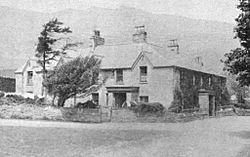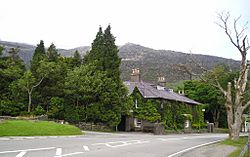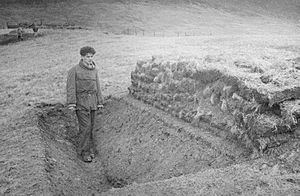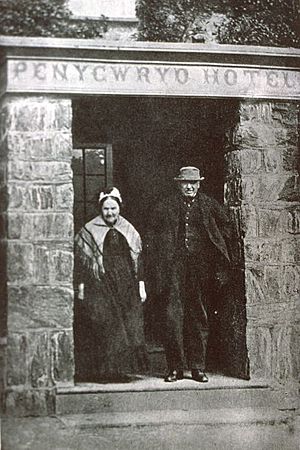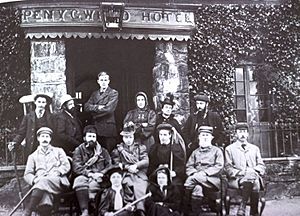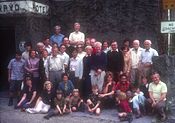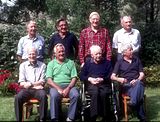Pen-y-Gwryd facts for kids
Pen-y-Gwryd is a special place in Gwynedd, Wales. It's a mountain pass where two rivers, the Dyffryn Mymbyr and Nant Cynnyd, begin. This spot is very close to the famous mountain, Snowdon.
Pen-y-Gwryd is important because it's where two main roads, the A4086 road and the A498 road, meet. These roads connect many towns like Capel Curig, Llanberis, Caernarfon, and Beddgelert. It's also near the Llanberis Pass, another well-known mountain route.
A famous hotel called the Pen-y-Gwryd Hotel is located here. It's a popular place for people who love climbing and exploring the mountains. The area also serves as a base for mountain rescue teams, helping people who get into trouble in Snowdonia.
Part of the modern A4086 road used to be an old path called the Miners' Track. This track was used by miners from the Snowdon copper mines. From a nearby spot called Pen-y-Pass, there's a popular walking route to the top of Snowdon called the "PYG track." Some people think "PYG" comes from "Pen-y-Gwryd," but it might actually come from an older name, "Pig track," which means "Pigs' Gap" in Welsh.
Ancient Roman Camp at Pen-y-Gwryd
Long ago, during Roman Britain, the Roman army built a temporary camp at Pen-y-Gwryd. This was a smart place for a camp because it was where three important routes through the Snowdonia mountains met. Roman soldiers built these camps every evening when they were traveling or fighting.
The camp was shaped like a diamond and covered about 4 hectares (about 10 acres). This was big enough for up to 2,000 soldiers and their gear. To protect themselves, they dug a ditch about 5 feet (1.5 meters) wide and 2 feet (0.6 meters) deep. They also built an earth wall, or rampart, that was 8 to 9 feet (2.4 to 2.7 meters) wide. Part of this old Roman wall actually runs right through where the Pen-y-Gwryd Hotel stands today!
Historians think the camp was first built around the AD 70s. This was when a Roman general named Gnaeus Julius Agricola was conquering the local Welsh tribes called the Ordovices. It's rare for temporary Roman camps to survive, so the fact that this one did suggests it was used many times. Even though no buildings were permanent, it was probably a regular stop for Roman soldiers traveling between their forts at Chester (called Deva Victrix back then) and Caernarfon (called Segontium).
Today, it's hard to see the camp because of time and how the land is used. Only grass and small mounds remain. The site was first explored in 1960 by students from Plas y Brenin, led by Dr. Josephine Flood.
The Pen-y-Gwryd Hotel: A Climber's Haven
The Pen-y-Gwryd Hotel started out as a farmhouse in 1811. It was turned into an inn by John Roberts from Llanberis. Later, in 1843, a woman named Mrs. Hughes took over.
In 1847, Henry Owen bought the inn. He was born in Beddgelert in 1822. Henry and his wife, Ann, worked hard to make the inn a success. Henry also worked at a nearby copper mine and farmed for a while. But by 1858, the inn was doing so well that he could buy the land it stood on.
Under Henry and Ann Owen, the inn became very famous for its comfort and warm welcome. They made the building much bigger, turning it from a simple farmhouse into a well-known hotel. Ann's amazing cooking was a big reason for the hotel's popularity!
The hotel became a central spot for the growing sport of mountaineering in North Wales. In 1898, a group called The Climbers Club was even started at Pen-y-Gwryd. They said the hotel had a "congenial atmosphere" that helped their club begin.
Another group, the Society of Welsh Rabbits, started in the 1860s. They loved exploring Snowdonia in winter. Ann Owen said in 1895 that after this group praised Pen-y-Gwryd as a great Christmas spot, the hotel was always full during the holidays. Henry ran the hotel until he passed away in 1891, and Ann continued until her death in 1896.
Later, William Hampton, along with Arthur and Florence Lockwood, took over. They brought back the hotel's strong links to mountaineering and improved the building. In the 1920s, they even created a small trout lake opposite the hotel, called Llyn Lockwood. During World War II, a school from Bexhill-on-Sea used the hotel.
The owners since then have continued to improve the hotel. They have also made sure it remains a key place for mountaineers. It's now a mountain rescue post, and a special sign is still on the main entrance. Each guest room is named after one of Snowdonia's 13 highest peaks.
Pen-y-Gwryd's Links to Famous Expeditions
The Pen-y-Gwryd Hotel has a very special connection to some of the most famous mountain climbs in history. The teams who made the first successful climbs of Mount Everest in 1953 and Kangchenjunga in 1955 used the area for training. They even tested their oxygen equipment nearby.
Inside the hotel, there's a special dining room called the Stüberl. On its ceiling, you can see the signatures of the brave climbers from both the 1953 Everest and 1955 Kangchenjunga expeditions. These include famous names like Sir Edmund Hillary, Tenzing Norgay, Sir John Hunt, and Joe Brown. The hotel also has many photos and items from these historic climbs.
Every five years, the Pen-y-Gwryd Hotel hosts special reunions for the Everest and Kangchenjunga teams. This keeps their amazing stories alive.
Caradog Jones, the first Welsh person to climb Everest, said that the hotel's connection to the mountain was what inspired him to achieve his dream.
Many other famous people have visited the hotel over the years. These include writers like Charles Kingsley, politicians like William Ewart Gladstone, and explorers like George Mallory. Even actor Jack Hawkins stayed there while filming a movie in Snowdonia.


